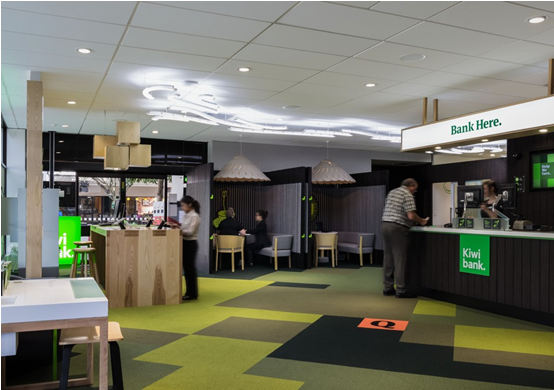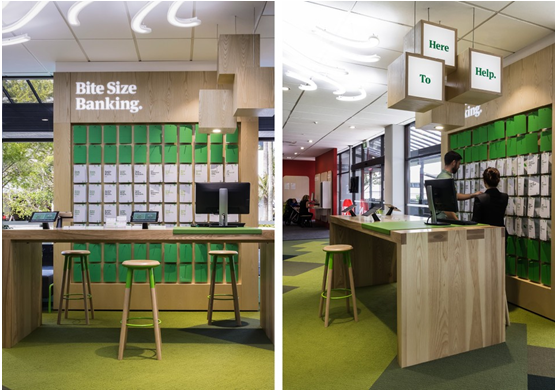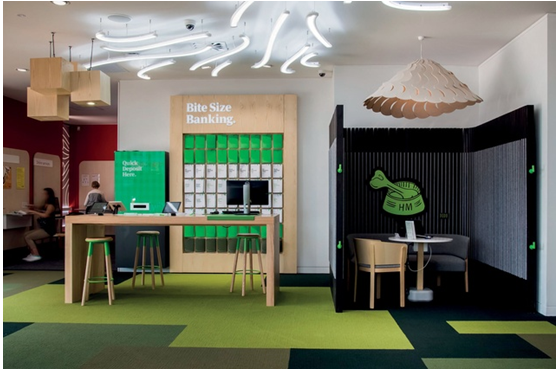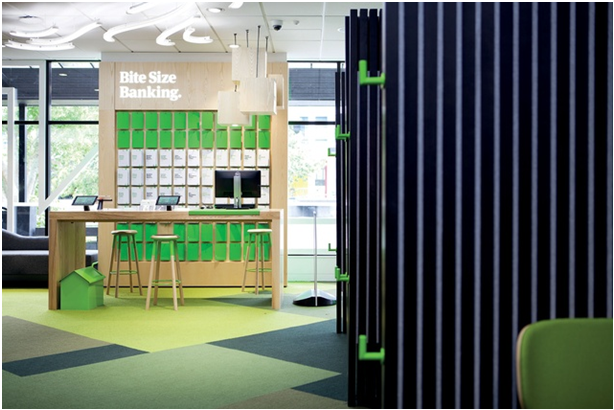Post-GFC, the market is so over the stuffy and traditional – we humans need something beyond the old “transactional culture,” right guys?
Redesigning the new finance sector
Design is playing a huge role in crafting new and better worlds. The finance sector is an interesting example where design is making positive and seismic shifts. In collaboration with Interface, NZ’s Kiwibank and NZ Post project by Designworks conceived a new breed of finance.

Unlike the drab and transaction-centered bank of yester-year, “The new retail experience was designed around the concept of ‘comfortable conversations’,” says Designworks design director, Clark Pritchard, “developed as part of the overall Retail Transformation Project.”

Off the back of extensive prototyping and user-testing, the stores have uniquely designed spaces that encourage and cater to specific conversations; high top work surfaces enable quick, independent browsing and casual conversations. Booths with partial screening create discreet spaces for informal meetings.

Some of the old traditions however, cannot be trashed so readily, and so for more serious business matters there are private meeting spaces. Also integral to the success of the store is the creation of two distinct offerings of Kiwibank and NZ Post to clarify the previously chaotic and fragmented mixture of banking and NZ Post services, for a more cohesive and communal experience.
“Initially it was very much about creating a banking experience to compete with the rival banks and the get Kiwibank up to their standard,” Clark explains. “However, it quickly became apparent that we didn’t want to be like the other banks and that we should build on the uniqueness of Kiwibank; who they are and what their brand means to New Zealanders and take it a step beyond your average bank experience.”

Here, it was about creating a Kiwibank experience the New Zealanders could relate to, engage with and be proud of, a retail experience that none of the other banks could compare. And would of course call for some new and positively disruptive design methods.

Clark notes: “We approached the design not from your typical number eight-wire approach, but from a very modern and innovative way in which Kiwi’s are viewed out in the world, in coming up with solutions that were simple, well designed, sustainable and pragmatic.”
Embracing the unexpected
Ultimately, this lead Clark and the Designworks team to select off the shelf materials and use them in ways they had not been used before, but which also had a meaningful, local flavor.
“This stemmed from us researching furniture from overseas and one day realising that we have fantastic design talent in New Zealand, so why not collaborate with them to design furniture and fittings specifically for Kiwibanks’ customers? We engaged Jamie Mclellan, David Trubridge, Tim Webber, Nathan Goldsworthy and Tim Wigmore to design a furniture and lighting range for the branches, which has been tremendously successful and gives a true point of difference to each branch. The flooring concept inspiration came straight from local NZ flora, specifically an aerial view of the Canterbury Plains and farmland as a reflection of Kiwibanks grass roots history and approach.”

Society in general is changing. We are seeing more and more that consumers and users, across any number of industries, are expecting something more meaningful that the “buy it, use it” culture. More than anything, people want a connection, to be inspired by ideas beyond a product or service. And design as a practice has a real responsibility to create these new breeds of culture. Design houses such as Interface and Designworks represent what design is truly capable of; designing a better world.